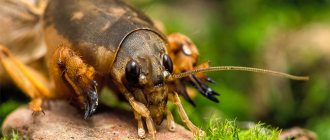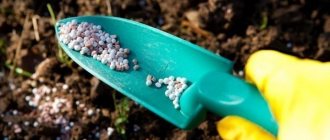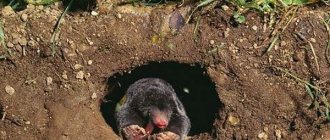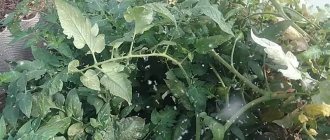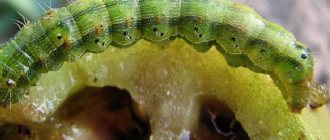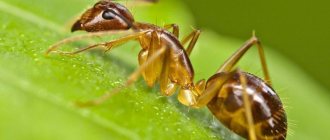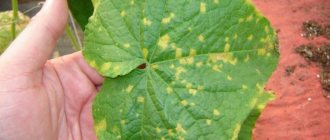You need to fight slugs, especially if they appear in the greenhouse. In open ground, pests are not so dangerous, but in a closed building they can completely ruin the harvest. In view of this, if you notice even one small individual, treat the greenhouse area as quickly as possible. Better yet, prevent the appearance of insects.
Why am I fighting slugs in the greenhouse?
In my area, I sometimes notice the “naked slug” variety. The small mollusk settles not only in open areas, but also in greenhouses, cellars - wherever there is high humidity and shade.
Their harm to cultivated plantings is great - they love to feast on fresh, young plants with soft and succulent foliage. But plantings with hard tops are avoided. The most favorite food of gastropods is cabbage: white cabbage, broccoli, cauliflower, Peking cabbage, Brussels sprouts.
Therefore, in order not to lose the harvest, I begin to fight the pest as soon as the first individuals are found in the greenhouse. If the problem is neglected, voracious mollusks will fill the entire space of the greenhouse, destroying valuable plantings.
Preventive measures
The fight against slugs should begin as early as possible, and not after the discovery of the first chewed leaf or silvery mark. In early spring, you need to thoroughly loosen the soil and plant plants at the recommended intervals. Install as few shelves and drawers as possible, because these are where parasites hide. Carry out preventive, organizational, economic and agrotechnical measures on time. The area around greenhouses must be kept clean and weeds must be removed in a timely manner. And then the plants will be pleased with healthy leaves and a good harvest.
Signs of slugs in a greenhouse
I learn about the “adventures” of gastropods by their characteristic features:
- Damage only to soft, delicate plant tissues - eaten away spots and holes remain on the leaves.
- Silvery shiny traces remain along the route of the pests. You will see them on the leaves, on the soil, and on the walls of the greenhouse. Mucus is produced by gastropods to facilitate movement, as a protection against drying out of the body.
Having determined that slugs have settled in the greenhouse, I do not put off getting rid of them.
Electrical barriers
This method will not reduce the number of pests, but will only limit their access to plants and fruits. Therefore, electrical barriers are best used in greenhouses. Structurally, the barrier is a self-adhesive tape with exposed current conductors.
Electric barrier against slugs
Attention! The current strength and voltage in electrical barriers are so small that they are not that dangerous to humans; a person is not even able to feel the discharge.
The principle of operation of an electrical barrier is that when a slug or snail comes into contact with the conductors, they receive a small discharge, become confused and “change their mind” to move further towards the intended target in the form of a ripe squash or squash.
Chemical methods for getting rid of slugs in the garden
The fastest way to get rid of it is to use store-bought pesticides. But it has a lot of disadvantages:
- Destroys not only slugs, but also beneficial insects. Not safe for pets.
- A waiting period is required - early harvesting of greens can lead to serious poisoning.
- Chemicals are not safe for humans. It is better not to bring children to the site for approximately 5-7 days after treatment. The procedure itself must be carried out taking care of personal safety - wearing closed clothing and shoes, a respirator, and safety glasses.
- Part of the product will inevitably end up in the soil - the chemicals completely decompose within a month. Throughout this period, garden plantings will absorb toxic substances from the substrate.
Both complex (against all garden pests) and special formulations are effective against slugs. Among the most popular:
- "Storm";
- "Slug Eater";
- "Ferramol";
- "Predator";
- "Stopulit";
- "Bros Snakol";
- "Meta";
- "Schnecken Linsen."
A safer drug is special fertilizers. They do not contain toxic chemicals, but they contain substances that mollusks do not like. Among the most effective are calcined mineral fertilizers. But I only use them at stages when greenhouse plants really need feeding.
I do not recommend scattering dry mineral fertilizers over the garden bed in hopes of controlling slugs. Oversaturation of the substrate with calcium and salinization of the soil are no less harmful to plantings than an invasion of pests.
Another method I tried was iron sulfate. I sprinkle a little product on the migration routes of gastropods - they can be easily identified by their characteristic shiny trail. I also dust the perimeters of the beds. But I try to use fertilizer in reasonable quantities so as not to harm the plantings.
Iron sulfate is good because it does not lose its properties when exposed to sunlight or water. Does not wash off during heavy rains or watering. Slugs quickly die from contact with the substance before reaching the “feeder”.
iron sulfate against slugs
Who are we dealing with?
Snails are called gastropods. They are nocturnal. Sometimes snails hunt in cloudy weather during the day.
A snail differs from a slug in that its body is protected by a shell. It is three-layered: horny, medium-limestone and mother-of-pearl. For this reason, this type of mollusk is usually found on limestone soils. The breathing process is carried out through the hole located on the right side of the sink. There are tentacles on the surface of the head.
Long “horns” carry out the visual function. These organs detect light intensity, touch and smell. The sense of smell is highly sensitive. For this reason, gastropods sense prey at a 2-meter distance. There are more than 15 thousand sharp teeth in the mouth to grind food.
Agrotechnical methods for getting rid of slugs
Effective and safe ways to eliminate uninvited guests from the site are useful agricultural techniques. I'll share what I use myself:
- Regulation of soil moisture. I wrote above that slugs prefer a consistently moist environment. You can combat them by adjusting the watering schedule - reduce water procedures as much as possible to create uncomfortable conditions for slugs. I use a little trick - after watering, I sprinkle the greenhouse beds with a thin layer of dry garden soil.
- Mulching. The delicate bodies of slugs will not like obstacles such as eggshells, wood chips, or sawdust. Mulch also optimizes the humidity of the substrate, absorbs moisture, remaining dry after watering, which is uncomfortable for mollusks. Slugs will also find any sharp, rough or rough surface of the mulch unpleasant.
- Attracting natural enemies. In the wild, slugs are a favorite food of frogs and hedgehogs. Attract animals to your property by building shelters for them.
- Planting “unpleasant” plants. From my own experience, I judge that slugs do not like the specific smell of lavender, thyme, laurel, parsley, rosemary, sage, and santolina. Therefore, I try to plant these crops around the perimeter of the greenhouse.
I find agrotechnical means to be preventive – in the event of an invasion, I turn to more radical methods of struggle.
Traditional methods of fighting slugs in a greenhouse
I’ll also tell you about popular folk remedies, whose effectiveness I have verified through my own experience.
Spices
An excellent panacea for voracious shellfish is ordinary kitchen seasonings. I sprinkle spices on the surface of beds attacked by pests. The most effective is red pepper. But rosemary, cilantro, and black pepper are no less effective.
Small particles of seasoning irritate the delicate body of slugs, and sometimes leave serious burns, from which the mollusk dies. This scares pests away from the greenhouse and forces them to look for new habitats.
The disadvantage of this method is its short duration. Gastropods quickly develop immunity to spices - the offspring of surviving individuals already crawl freely over the obstacles of spices towards fresh foliage.
Beer
Like mole crickets, slugs are attracted to the smell of this alcoholic drink. So I use it to create a hook:
- I pour some beer into the bottom of glass or plastic jars.
- In the evening, I bury the containers in the greenhouse so that the neck is level with the surface of the earth.
- Since slugs are nocturnal, they will crawl towards the traps at night. In the morning I collect the “catch” by hand.
For several days in a row I replace the stale drink with a fresh one and fish out any pests from the cans. If you don't buy beer, you can replace it with kvass, fermented juice, jam or compote.
Plant traps
A simple, economical and safe method for removing slugs from greenhouses. Place fresh vegetable waste between the rows - I use cabbage leaves, tops of tomatoes, cucumbers, and lettuce.
To destroy as many pests as possible, I collect them early in the morning, before the sun hits the greenhouse. In this way, I “kill two birds with one stone” - wood lice often visit plant traps.
Another old-fashioned method is the use of old boards. In the evening, I grease one side of the wood with kefir, yogurt or another fermented milk product. I place it on two bricks or stones with the smeared side down and leave it in the greenhouse overnight. The slugs arrive to the aroma that is appetizing to them - in the morning all that remains is to collect the gastropods.
Salt
A fairly effective method of getting rid of shellfish is regular salt. It is sprinkled on the migration paths of pests and gastropods themselves. Salt corrodes their bodies and leads to death.
But I do not recommend that you get carried away with this method, especially on beds with cultivated seedlings. This will lead to salinization of the soil, making it unsuitable for farming.
Variety of species
Gastropods are represented in large numbers. In the garden you can see more than 200 species of shellfish.
Features of the grape snail
The snail of this species is the most voracious and largest gastropod pest. The shell has an average diameter of about 6 centimeters. The leg has a size of 5-9 centimeters.
The grape snail lives from the Caucasus Mountains to the Leningrad region. Life expectancy is from 6 to 8 years.
The mollusk overwinters in the upper earthen layer or in fallen leaves. If the summer is dry, it sticks to fences, houses, trees and other surfaces. The shell is closed by the mollusk using a lime plug. After this, the gastropod pest can spend a certain amount of time in a state of anabiosis. It lasts from 3 to 5 months. During the season, a gastropod can lay about 300 eggs, from which a large number of new pests will subsequently appear.
Characteristics of a garden snail
It is one of the most harmful. The shell has a spherical shape, its diameter is 2 centimeters. The garden snail has a special love for bushes and tall grass. It does not die even in frosty weather. Withstands 40 degrees below zero.
This species of mollusk lives everywhere, excluding Siberian and northern latitudes. The garden snail's diet consists of green parts of plants.
This type of gastropod is distinguished by its speed. It can cover a meter distance in a minute. In a short time, the pest is able to colonize a large area.
The harmfulness of Helicella
The gastropod is one of the most harmful that live in the European part of the Russian Federation. Usually lives in greenhouses and shelter structures. It is comparable in size to grape, slightly inferior to it. Helicella grows up to 3 cm in size.
Arianta difference
Arianta is an arboreal species of gastropod. The habitat of the pest becomes garden areas, places where there are large numbers of tree seedlings. The difference between Arianta is that the shells are somewhat transparent. Spots of different sizes and shading are located on its surface in a chaotic manner.
There are other varieties of snails found in gardens and orchards. They can cause great harm to plants. For this reason, destruction should begin as soon as the mollusk is discovered. Otherwise, you may lose the entire harvest.
How to get rid of slugs on flowers
Gastropods also love to eat decorative plantings. Hosts are especially attractive to them. I made an interesting observation: the pest gnaws the petiole of a leaf - it falls to the ground. The mollusk descends and climbs under the leaf, receiving both a “house” and provisions.
I fight slugs in the flower garden in the same ways:
- I make water traps - I dig containers of liquid level with the ground, adding it as it dries.
- I mulch the flower beds with peat, ash, sharp walnut shells, sand, coffee and tea.
- I struggle with shading and high humidity - I prune and tie up spreading plantings.
If there is a dominance of slugs, you can turn to chemicals - “Thunderstorm”, “Slug Eater”, “Predator” and so on.
How to get rid of slugs in the garden
Keep in mind that not only slugs can spread in the garden, but also pests similar to them, against which other methods are effective. Black “slugs” often crawl on pear and cherry leaves. These are actually the larvae of the slimy cherry sawfly. To combat them, it is better to use Kinmiks. "Bitoxibacillin", "Inta-Ts-M".
When real slugs appear in my garden, I solve the problem by building a simple trap:
- I take an ordinary plastic cup and put a treat on the bottom - juicy grass, beer, pieces of fresh vegetables, cabbage.
- I lower a tube into the container through which the mollusk could easily crawl through. But in such a way that it does not touch the bottom of the glass.
- The easiest way is to pass the tube through a tight lid, make a hole in the latter, and seal the glass tightly. If there is no lid, then the container can be closed with tape, adhesive tape, cling film - so that there are no other entrances in the glass except the tube.
- I bury the glass up to the neck in the soil. I lower the tube level with the surface of the earth so that the slug can easily climb into it.
The trap is ready - the pest, sensing the bait, will climb into the cup, from where there is no exit. All I have to do from time to time is collect the mollusks I come across and refresh the bait.
I don’t forget to check the cellar in the garden house:
- I arm myself with a bucket of water and a flashlight and collect pests from the walls by hand.
- In the fall, when there are no supplies in the cellar, I dust the walls, floor, and ceiling with a mixture of chalk and ash. If there is an invasion of gastropods in the storage facility, it is more effective to use a sulfur bomb.
Another simple and safe trap is pieces of linoleum, roofing felt, old boards, plastic, and a bunch of plant debris. Any shelter that will be attractive must be damp, dark and warm. All I can do is lift the traps from time to time and collect hidden mollusks from there.
slug trap
Living enemies
In nature, slugs and snails have natural enemies. They can become reliable assistants in pest control. But to do this, you will first have to attract them to the site.
Will help get rid of slugs and snails:
- Starlings. Place several birdhouses on the site. At first, make sure that the feeders contain food for birds that will attract them. Gradually, starlings will begin to independently look for food for themselves.
- Lizards. They actively feed on slugs and snails. To attract them to your garden, place decorative stones that will not only provide decoration, but also provide shelter for the lizards.
- Frogs. There should be at least a small pond on the site. This is a habitat for frogs and a wonderful decoration for the site.
- Ground beetles. These are dangerous, fast and predatory insects. Ground beetles require certain living conditions. They prefer to settle in damp depressions, where they dig comfortable burrows for themselves. Not only adult insects, but also their larvae are very bloodthirsty. They feed on smaller slugs, fly larvae, caterpillars and wireworms. The larvae live in damp mulch and hunt there.
Birds, lizards, frogs and insects settle only in those areas where various chemicals are not actively used.
Preventing the appearance of slugs in the greenhouse
Although I know how to quickly and easily remove pests from a site, I still try to prevent their appearance:
- I make sure the garden is well-groomed and clean. “Plantations” of weeds are an excellent place for life and reproduction, from where they spread throughout the entire garden, including greenhouses. I don’t allow heaps of plant waste to form where it’s dark and humid – I store it in time and burn it. I don’t forget to thin out cultivated plants - the abundance of side shoots and constantly moist soil attract gastropods.
- I do not practice continuous, thickened plantings. This environment is the most comfortable for slugs. They exist in optimal humidity, protected from the sun, and have unlimited access to foliage. I thin out the plantings, remove unnecessary lower branches, ensure good aeration in the greenhouse - I periodically ventilate the greenhouse.
- I do not allow pests near food sources. Slugs do not fly and do not dig underground passages, which is why it is quite easy to build barriers for them. Protect the ridges with slippery plastic panels or sheets of iron with sharp edges, burying them 3-5 cm into the ground. If you have children, it is better to replace such traumatic obstacles with small ditches with nut shells or eggshells - slugs will not be able to overcome such protection.
- I mulch the beds. I try to cover the ground around plants attractive to slugs with a thin layer of sawdust, fine sand, gravel, and broken shells. Tiny particles of mulch stick to the clam's wet body, preventing it from moving toward food. Ash acts in a similar way. I spread a protective layer of ash around the plantings. Sticking to the bodies of slugs, it irritates and burns their integument.
- Watering with warm water. The method is good only for cabbage plantings - it can harm other crops. Gastropods do not like to settle in beds that are watered with water heated to 40-50 C.
Eliminating slugs from your site is not an easy task, but it can be done. Conventional manual harvesting, agrotechnical techniques, and folk methods are also effective here. If the pest is dominant, use pesticides after weighing the pros and cons. But the easiest way is to turn to prevention in order to prevent the appearance of harmful gastropods in the garden.
What attracts shellfish
There are many types of garden slugs. In each region of Russia, depending on the climatic zone, its own specific species predominates. But regardless of their species category, slugs are attracted to the taste of fresh vegetables and shoots. What do slugs eat? As a rule, the leaves of vegetables and fruits are very fleshy, juicy, healthy and nutritious. This is what attracts pests. The speed of movement of slugs is low, but despite this, they expend a lot of energy. Therefore, their life turns into a continuous race for food.
Unfortunately, no varieties have yet been bred to which slugs will be indifferent. They attack vegetable crops, berries, and fruits. There is practically no escape from them. Slugs can even appear in a greenhouse, because the availability of plants, high temperatures and humid air make it an excellent habitat.
But in addition to plants, slugs can also be attracted to food. You may be able to divert the attention of these pests to other objects by carefully placing traps around the garden.

